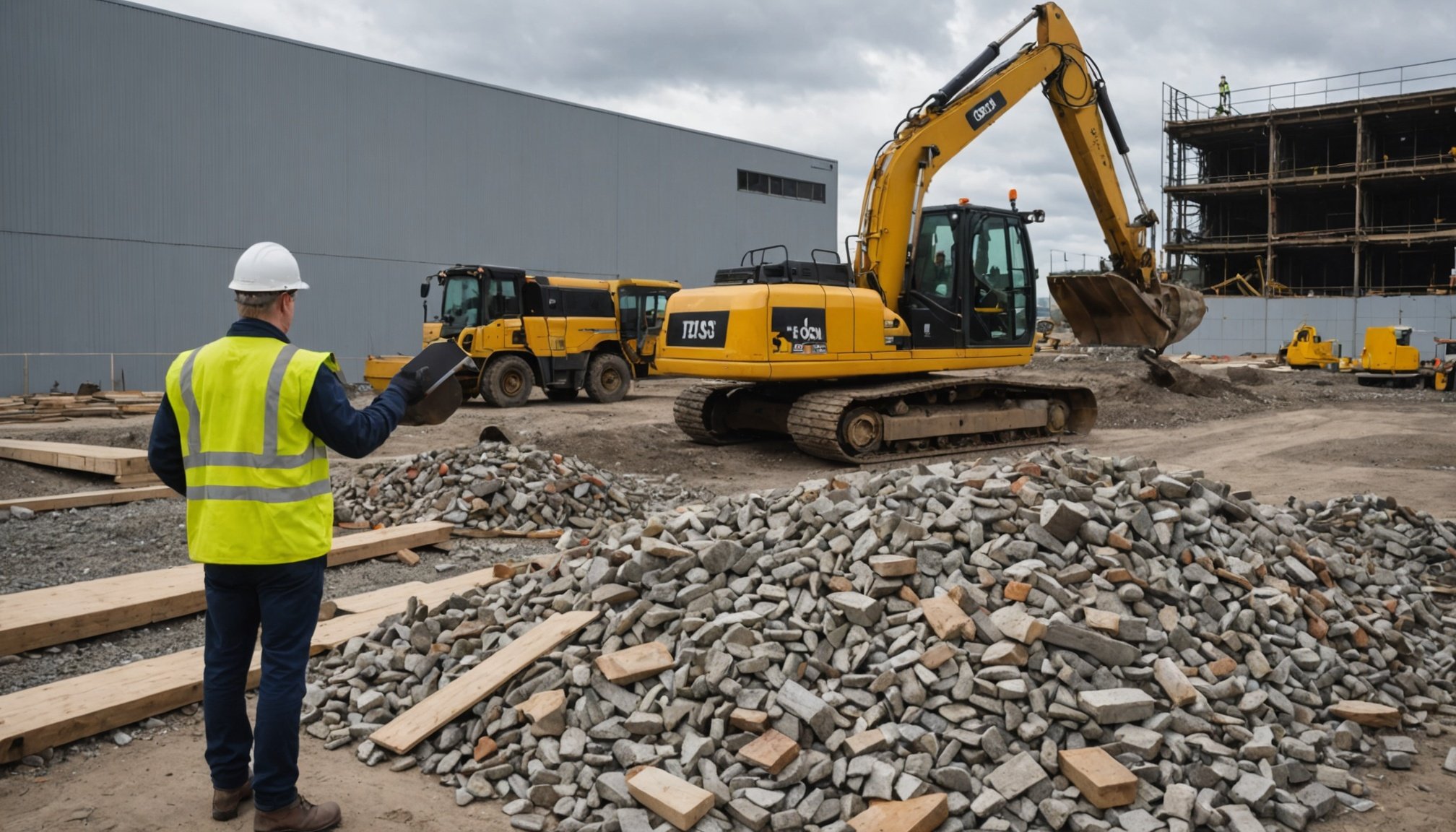Overview of Waste Reduction in UK Construction
The UK construction industry is recognising the importance of effective waste management in construction to boost sustainability practices. Waste reduction has become crucial due to its environmental, economic, and social impacts. Construction waste accounts for a significant portion of the UK’s landfill usage, highlighting an urgent need for change. In modern construction practices, sustainability drives innovations that not only reduce waste but also enhance project efficiency.
Current statistics reveal that construction accounts for over a third of the UK’s total annual waste. This staggering figure underlines the critical need for improved waste management strategies. The industry has seen a gradual shift towards recycling and reusing materials, decreasing reliance on raw resources. More companies are now implementing sustainability practices, such as using environmentally friendly materials and methods, to minimise their carbon footprint.
Have you seen this : Transform your warehouse with innovative industrial racking systems
Measures like adopting modular construction and using digital technology have shown to reduce waste substantially. Modular construction allows for components to be manufactured in a controlled environment, slashing material waste and speeding up the building process. Digital technology, through Building Information Modelling (BIM), optimises material usage by enhancing planning and execution efficiency, effectively contributing to substantial waste management in construction.
The construction industry’s commitment to these practices is integral in steering the sector towards a sustainable future.
Also to read : Empowering uk charities: innovative strategies to enhance volunteer participation and engagement
Effective Waste Management Techniques
In the construction industry, adopting efficient waste management techniques is pivotal to enhance sustainability and operational cost-effectiveness. One of the foremost strategies in reducing onsite waste generation is implementing comprehensive waste reduction strategies. This involves careful planning to ensure that materials are utilized effectively, thereby minimizing leftovers. For instance, ordering materials with precise measurements can significantly curtail construction waste.
Equally important is the significance of proper waste segregation. By segregating waste at the source, materials such as metals, plastics, and concrete can be separately collected for recycling or appropriate disposal. This process not only facilitates easier breakdown and recycling but also reduces the volume of waste reaching landfills, promoting environmental responsibility.
Moreover, construction firms are encouraged to implement a waste tracking system. Such systems provide a detailed account of waste types and volumes generated, allowing for better insight and management. With technological advancements, digital platforms can track waste metrics, providing analytics that guide the optimization of waste management processes.
Incorporating these effective waste management techniques not only enhances sustainability in projects but also builds a firm foundation for eco-friendly construction practices. By minimizing waste and optimizing resource use, construction sectors can contribute significantly to environmental conservation.
Recycling Methods and Best Practices
In the realm of construction, the pivot to sustainability hinges significantly on effective materials recycling. A circular economy approach underlines this shift by focusing on the continuous reuse of resources. Vital to this process is understanding the types of materials most commonly recycled in construction. For instance, concrete, metals, and wood stand out due to their prevalence and potential for reuse. Concrete, in particular, can be crushed and used in new projects, minimizing waste and reducing costs.
Several UK firms exemplify successful recycling initiatives. For example, a construction company in London utilizes a closed-loop system in which waste concrete is recycled into new projects, enhancing resource efficiency and reducing landfill use. Their adept recycling of traditional materials sets a benchmark for others.
To effectively integrate recycling into construction processes, consider practical tips like setting up designated recycling zones on-site. This not only streamlines sorting processes but also boosts overall efficiency. Incorporating recycling management software can further optimize operations, ensuring that waste is minimized and resources are reused in the most effective manner. By embedding these strategies, construction firms can contribute significantly to a greener future while enhancing their operational efficiency.
Sustainable Materials Selection
Choosing sustainable materials is crucial for the advancement of eco-friendly construction. The selection process often begins by assessing materials against specific criteria such as their environmental impact, durability, and availability. It is essential to prioritise materials that have minimal environmental footprint.
Criteria for Selecting Sustainable Materials
When selecting sustainable materials, consider their lifecycle, energy efficiency, and the potential for reuse or recycling. Materials should be non-toxic and produce little waste during manufacture. Opting for those with certifications like BREEAM or LEED in the UK ensures compliance with green standards.
Examples in the UK Market
In the UK market, several green building materials have gained popularity:
- Bamboo: Often utilised for flooring, it is both renewable and durable.
- Sheep’s Wool Insulation: Provides excellent insulation while being biodegradable.
- Recycled Steel: Commonly used in structural frameworks, reducing the need for virgin resources.
Benefits of Recycled and Locally Sourced Materials
Utilising recycled materials not only reduces waste but also conserves natural resources. Furthermore, locally sourced materials decrease the carbon footprint associated with transportation. This practice supports local economies and ensures construction projects are more sustainable. By making informed choices, the transition to greener construction becomes both achievable and beneficial.
Energy-efficient Practices
Incorporating energy efficiency in construction entails adopting innovative designs and advanced technologies to reduce energy consumption. This means utilising high-performance building materials, installing smart systems, and optimising natural resources. For instance, using triple-glazed windows and enhanced insulation can lead to significant energy savings.
Energy-saving strategies begin with conducting comprehensive energy audits and assessments. These evaluations identify areas where energy is being wasted and provide actionable steps to improve efficiency. By understanding energy consumption patterns, construction projects can implement sustainable energy solutions that cut costs and lessen environmental impact.
Let’s consider a case study from the UK, where a commercial building project focused on sustainable energy solutions achieved remarkable energy savings. By integrating solar panels, implementing smart lighting systems, and installing energy-efficient HVAC systems, the building reduced its overall energy consumption by nearly 30%. These changes not only minimised utility expenses but also contributed positively to the environment.
Embracing energy efficiency in construction is not only an environmentally responsible choice but also a financially sound decision. It’s crucial for the construction industry to continue evolving and implementing these energy-efficient practices to contribute substantially to a sustainable future. With the right strategies and technologies, significant progress is possible.
Regulatory Compliance and Industry Standards
Navigating construction regulations can be daunting, especially when it comes to waste management in the UK construction sector. Key regulations include the Waste Management Licensing Regulations 1994 and the Environmental Protection Act 1990, governing how companies manage and dispose of waste. Such frameworks aim to ensure that construction activities do not harm the environment.
Understanding environmental standards is crucial. The Environmental Impact Assessment (EIA), for instance, evaluates potential environmental effects of a proposed project. The EIA process requires developers to consider environmental protection before construction begins, making it a cornerstone of compliance. Projects requiring EIAs often need to demonstrate how they will achieve sustainable practices or mitigate adverse impacts.
Waste management compliance extends beyond simply following rules. It involves adopting practices that minimize waste production and encourage recycling to lessen the environmental impact. Steps towards compliance include implementing recycling programs on construction sites and selecting eco-friendly materials.
For those seeking resources to stay compliant with sustainability regulations, the UK’s Environment Agency website offers valuable guidance. Additionally, industry organizations like the Chartered Institute of Building provide updates and support for construction professionals to stay informed about evolving standards. Achieving compliance not only prevents legal issues but also enhances a company’s reputation and commitment to sustainability.
Implementing Change: Steps for Firms
In the construction industry, effectively executing change management requires a strategic approach. Start by crafting a comprehensive waste reduction plan, essential for reducing environmental impact, and enhancing sustainability. This plan must identify waste sources and incorporate precise methods for minimizing these outputs. Next, ensuring successful sustainability implementation necessitates robust employee training. Employees play a pivotal role in this transformation process. Engaging the workforce through regular workshops fosters a culture of environmental consciousness and equips personnel with the necessary skills to support sustainability efforts.
To further aid in this journey, employing a variety of tools and resources is crucial. Consider investing in technology and software specifically designed for tracking and analyzing waste metrics. Educational resources, such as online courses and real case studies, enhance knowledge on sustainability practices and keep the team updated on industry trends.
Lastly, regular feedback loops help assess the effectiveness of sustainability initiatives and make necessary adjustments. Encouraging open communication within the team facilitates the sharing of ideas and best practices, building a community committed to continuous improvement. With these steps, construction firms can not only meet regulatory requirements but also position themselves as leaders in sustainable building practices.
Conclusion and Future Directions
The concept of sustainable construction is not merely a passing trend, but a necessary evolution within the industry. As we look forward, embracing the future of sustainable construction involves focusing on technologies, strategies, and collaborations that significantly impact long-term outcomes.
Emerging Technologies
Cutting-edge technologies are poised to revolutionise waste reduction efforts. Innovations like 3D printing, advanced materials, and smart site management systems are pivotal in trimming resource waste. They’re fostering a new era where excess material is a thing of the past.
Long-term Sustainability Goals
The establishment of clear, measurable sustainability goals is crucial for ongoing success. Setting specific benchmarks, such as reducing carbon emissions or improving energy efficiency, will ensure alignment with global environmental commitments.
Collaboration Across the Industry
Achieving a sustainable future in construction requires robust collaboration. Stakeholders, from architects to logistics firms, must work harmoniously, integrating technologies and strategies to reduce waste. The collective efforts can lead to impactful change, optimising each project’s environmental footprint.
Looking ahead, the rise of sustainable practices in construction carries immense potential, promising to reshape our built environment positively. Emphasis on emerging technologies, aligned with well-set sustainability goals and collaboration, will fortify the efforts towards long-term waste reduction and overall industry progress.











